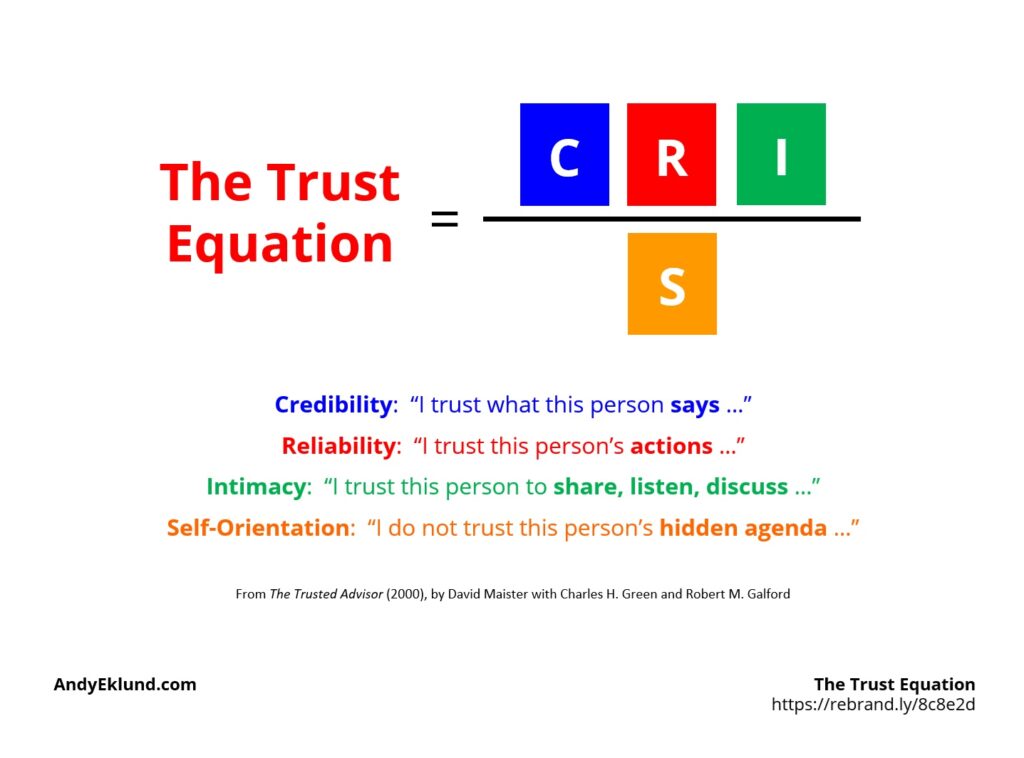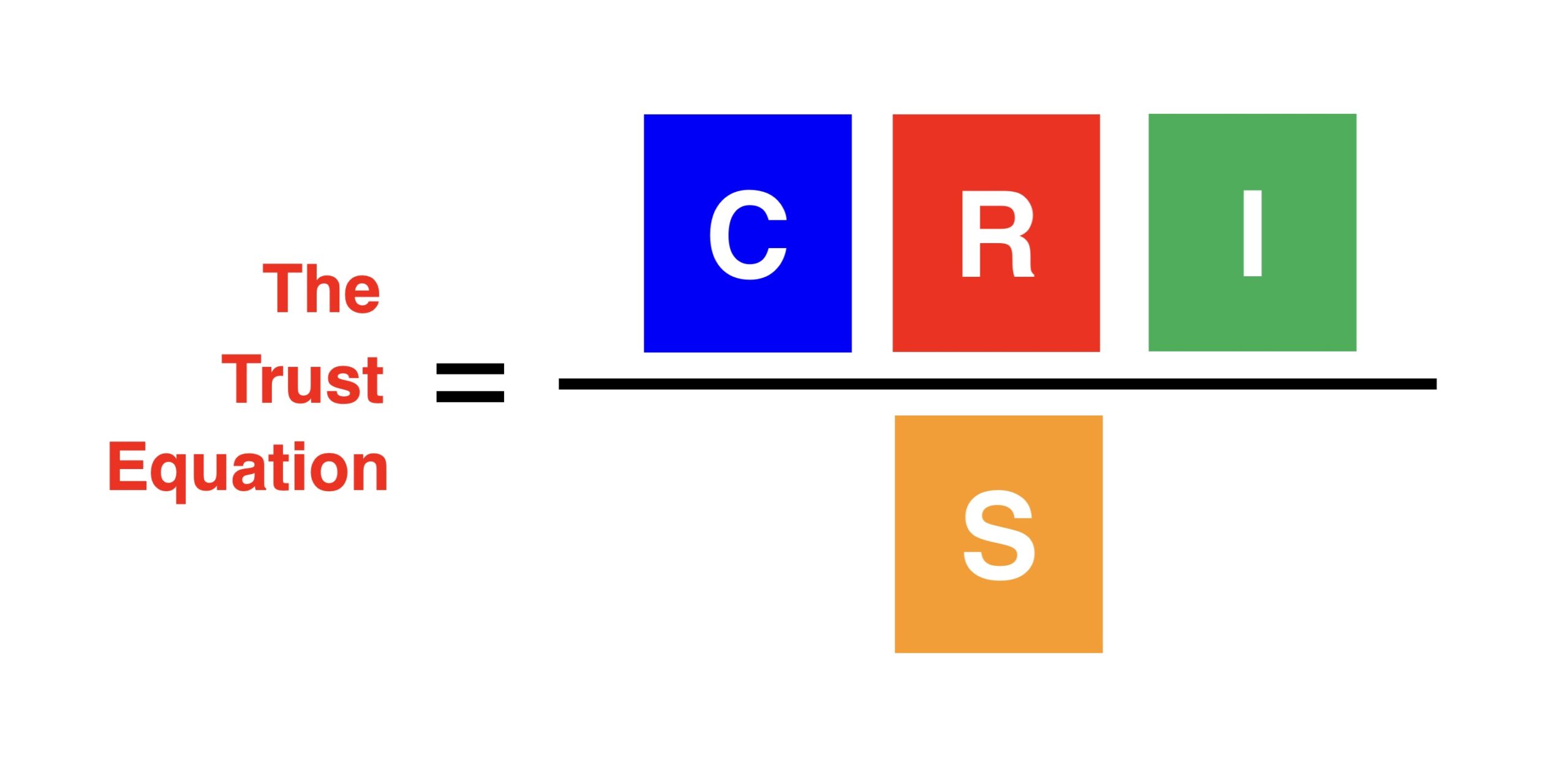One tool I use over and over in many different workshops is The Trust Equation. It’s a simple yet clever tool that yields insights into the four aspects that build – and destroy – trust in business.
Originally conceived for their 2000 book of the same name, Charles Green and Robert Galford teamed with David Maister to name and organise the critical aspects which build trust in business relationships using this mathematical “equation.” Along with rapport, trust with colleagues, partners or clients is one of the most important aspects to ensure success.
In their book (also updated in 2012), the authors define trust and how it’s used.
“We use trust to …”
- Interpret what people say
- Describe their behaviours
- Decide if we feel comfortable sharing information, and
- Indicate whether we think other people have our interest at heart.
The tool is both conceptual and analytical. Using a hypothetical mathematic equation as its basis, the tool is both conceptual and analytical as it breaks trust-building into four aspects, three of which …
- Credibility
- Reliability
- Intimacy
… focus on how and why to increase them in a relationship. The fourth aspect
- Self-orientation
… focuses on how to decrease them in a relationship.
Credibility is the First Part of the Trust Equation
… is about the words we speak. It’s demonstrated when someone says: “I can trust what she says about (Topic X) …”
The opposite is someone who just talks without listening or being sensitive to the audience.
To build your Credibility, consider any of the following. Talk about your …
- Background, either professional or personal
- Experience
- Expertise
- Knowledge
- Understanding of content based on objective sources, as well as ..
- Understanding of context, or why you think one thing or another without asserting too soon a specific opinion or POV
Other skills to demonstrate for Credibility include:
- Your problem-solving skills
- Your ability to “think on your feet” (advising how you’d manage or behave in a hypothetical current or future event)
- Honesty
- Believability
- Transparency
- Above all else, strive for accuracy: do not use exaggerations or hyperbole
Reliability is the Second Part of the Trust Equation
… is about the actions we take. It’s demonstrated when someone says: “I can trust her to do (X)…”
The opposite of Reliability is someone who’s irresponsible, never taking accountability.
To build your Reliability, you might physically demonstrate any of the following.
- Repeated, consistent experiences linking your promises to actions (for ex: status reports, WIPs)
- Appropriate follow-up with documentation (use their preferred format, not necessarily yours)
- Actions which are based on what they want, not what you want or think
- Within reason, provide access to you and others
- Absolutely no surprises
Other skills to demonstrate for Reliability include:
- Dependability
- Consistency
- Conscientiousness
- Self-control
- Adaptability
Intimacy is the Third Part of the Trust Equation
… is about emotional security we feel when trusting someone with something, like a piece of information. It’s demonstrated when someone says: “I feel comfortable discussing this with (X)…”
The opposite of Intimacy is someone who is mechanical, technical, or without emotion.
Let’s be frank that “intimacy” is not a word I’d use in business today as it was in the 2000s. Personally, I prefer to use the word empathy instead of intimacy.
To build this aspect, you might demonstrate any of the following.
- A discussion (if not agreement) between parties about the ’emotions’ of business (for ex: sharing stories how we survived in business, aka ‘our war stories’)
- Put forth a piece of information about yourself, and judiciously enquire about their personal life
- A shared understanding about how we treat others in business, such as professionalism or ethics, even discussing how we discuss issues and problems
- When appropriate, being an ally, confidante and a sounding board for someone else.
Remember too the cardinal rule of being someone’s confidante. Once it’s over, you never ever mention the conversation again. As my Nana Eklund said, die with their secrets.
Decrease These Aspects to Build Trust
Self-Orientation
… is about the person’s focus on themselves or their own positions or needs. It’s demonstrated when someone says: “In reality, I don’t feel like (X) cares about…”
To diminish “Self-Orientation,” you might consider these actions.
- Never behave in any way that suggests you have a hidden agenda, or that the only focus is you, your department or organisation. (This is especially true if you work in a consultancy)
- Never let emotions cloud decisions, actions or messages
- Never play ‘devil’s advocate’ without being constructive and specific
- Poor listening, or worse, competitive listening
- Inflexible thinking, especially being over-reliant on data, statistics and content
- Minimise any desire to:
- Look intelligent
- Be right – more so, to be seen as right by others
- Aggressively appearing ‘on top’ of things
- Avoid risk
- Always have the right answer
Some final things to recognise:
- Trust is personal. It’s about other people, not a business – or worse, a “brand.”
- Self-Orientation is the most crucial to understand, if not minimise. The emphasis is in the wrong place. Instead, when you don’t make yourself the centre of the universe, you’re free to focus on the other party.
- The Trust Equation aligns with the basic credo of sales. When you stop selling, you can put your focus on potential clients. More so, if they trust you (more), they will buy (more) from you.
- More intersting, much of The Trust Equation builds upon Aristotle’s Appeals of ethose, logoc and pathos.
Please add your thoughts or comments below. I’d love to hear how you’ve tried to build trust, whether it’s using the Trust Equation or other similar tools.



No comment yet, add your voice below!